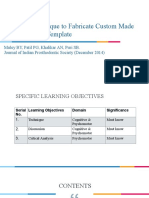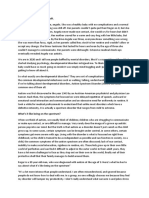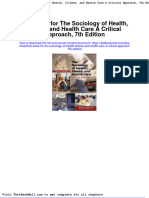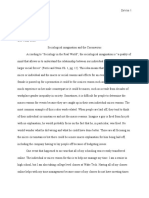Professional Documents
Culture Documents
Teaching Digital Skills Study at Middle and Higher Level in Chiapas, Mexico
Copyright
Available Formats
Share this document
Did you find this document useful?
Is this content inappropriate?
Report this DocumentCopyright:
Available Formats
Teaching Digital Skills Study at Middle and Higher Level in Chiapas, Mexico
Copyright:
Available Formats
Volume 7, Issue 9, September – 2022 International Journal of Innovative Science and Research Technology
ISSN No:-2456-2165
Teaching Digital Skills: Study at Middle and
Higher Level in Chiapas, Mexico
Flor Ivett Reyes Guillén Orlando Uriel Bravo Argüello
Facultad de Ciencias Sociales Facultad de Derecho
Universidad Autónoma de Chiapas Universidad Autónoma de Chiapas
San Cristóbal de Las Casas, Chiapas, Mexico San Cristóbal de Las Casas, Chiapas, Mexico
Socorro Fonseca Córdoba
Facultad de Ciencias Sociales
Universidad Autónoma de Chiapas
San Cristóbal de Las Casas, Chiapas, Mexico
Abstract:- This article shows the results of an Without a doubt, in a short time there will be studies that will
investigation carried out in Chiapas, Mexico, a state with consider, at a global and regional level, the reduced costs of
high marginalization and with a population living in working from home and the social benefits for it.
poverty and extreme poverty. The context is necessary
given that the main objective was to know the digital In this need to change behaviors, habits, we bring to the
competences of teachers at the upper secondary and present the theory of reflection, which expresses that the
higher levels. It was at the beginning of this century (XXI) learning activity pursues information capacity and the
when a new line of work emerged in the training field, generation of knowledge that allows forming habits (Israel,
aimed at incorporating ICTs in educational systems 2004). The formation of habits is an element that is pursued
through even new curricular designs. Teachers were as a preventive way and to reduce infections by Latin
expected to be prepared, but two decades later there is a American governments in the face of the pandemic, which
reality where the basic level of knowledge about ICT aims to reduce economic costs and increase health care
management is insufficient. capacity. Even though the populations show a great capacity
to understand, judge and transmit information regarding the
Keywords:- Digital Skills, Education, High School, And disease, the action measures of the population are deficient,
University Professor. and this is reflected in their contagion, morbidity, and
mortality figures.
I. INTRODUCTION
Within this reality, the use of technologies for most
The COVID-19 pandemic has meant that since 2020 the economic activities and services plays a preponderant role
world has been digitized with unprecedented speed. In the guaranteeing, through the digitalization of work, the
world of education, a digitization of processes had been protection of human rights by providing public services,
taking place with some resistance from the teaching education, prevention, and health care. The populations were
community at the different educational levels. protected, and the current generation is being educated for a
life that demands self-care and the safety of human
Given the confinement mechanisms in various populations.
countries, it has left the virtual modality as the only way not
to interrupt academic activities. This, however, has caused The paternalistic factor of governments is a crucial
teachers at all levels and especially at the upper secondary and element to understand that, from social cognition, the
higher levels, who worked in face-to-face modality, to have resolution of any event must be resolved solely by the
many difficulties when abruptly switching to a relatively new government, ignoring individual responsibilities (Morales
modality for them, accentuating the concern of authorities and and Prego, 2002); but today, for the humanity of 2020, it is
teachers themselves about their digital skills. necessary to resolve the situation from each one for all and
from all for each one, guaranteeing the involvement of society
At the end of the 20th century and the beginning of this and government to open new development options.
21st century, before the COVID-19 pandemic began, there
was still discussion about ways to introduce the world to the The forced use of technologies and the digitization of
use of technologies that would make us produce more quickly work generates several questions, among them, what are the
and reduce the times and including costs (Blanco, 2020; digital skills that high school and higher-level teachers have
Álvarez and Harris, 2020). The contagion prevention in Chiapas?
measures used by most countries, healthy distance, and social
confinement, have been factors that led to the dominance of
technologies to continue human activities from home.
IJISRT22SEP1022 www.ijisrt.com 1528
Volume 7, Issue 9, September – 2022 International Journal of Innovative Science and Research Technology
ISSN No:-2456-2165
Based on the above, this document presents the results the teaching work since it is not enough to transmit
of a research project on the digital skills of teachers at the knowledge in traditional chairs, but to educate requires the
upper secondary and higher levels in Chiapas. manifestation of multiple competences, among them the
digital ones (Morales, 2013), that although in confinement
II. METHODS due to the COVID-19 pandemic accelerated its use, it is also
true that it showed us its potential for the world and the
This study was conducted from Chiapas, Mexico, framework of this technological reality. But it also made
through an online survey, through Google forms, in Spanish. evident the lack of teaching skills for these educational
It remained on the platform until the sample reached a size of practices using ICT (Sánchez, et al, 2021).
n= 350 participants. The questionnaire was structured
according to the need to gather information regarding the Although the findings in this study show us that there is
digital skills that high school and higher-level teachers not total ignorance in the use of technologies, maintaining a
consider they have. The only selection criterion for the sample basic level of digital skills in high school and higher-level
was to be a high school and high school teacher in Chiapas. teachers requires attention. This is also undoubtedly a reality
that results from the frank resistance to change, a specific
III. DISSCUTION change in the inclusion of technologies in the educational
environment.
It is interesting to find that the area of specialization
with the highest percentage of teachers is social sciences This reality was glimpsed from the first years of the
(54%), followed by natural sciences (15%) and mathematics current century, when a new line of work emerged in the
(13%), the remaining percentage (18%) corresponds to training field, oriented to the incorporation of ICT in
various disciplines such as physics, English teaching, educational systems through even new curricular designs
physical education, Spanish. (Colás and Pons, 2004). Teachers were expected to be
prepared, but two decades later there is a reality where the
In terms of digital skills, we have: basic level of knowledge about ICT management is
Browsing, searching, and filtering information, data, and insufficient.
digital content: Only 10% say they know how to use
advanced mechanisms for searching and filtering reliable IV. CONCLUSION
information. The majority (69%) know how to navigate
the Internet and locate information or digital educational The activities today structured and carried out virtually
resources in different reliable formats; but generally. The require us not to stop and guarantee permanently active social,
rest (21%) know that the internet can be a good source of economic, educational, and cultural life. In general, around
information, but do not know how to find reliable 70% of the teachers who participated in the study have basic
academic information. digital skills; the remaining 30% consider that they have
Evaluation of information, data, and digital content: extensive knowledge in ICT management and allow them to
Evaluates the quality of the educational resources found share information through digital media, platforms and even
on the Internet, through clear procedures, 38% of the programming of specific tools for their teaching work.
sample. The rest know that there is a lot of information;
but they only perform a basic evaluation of it. The foregoing reveals that teachers, at the upper
Storage and retrieval of information, data, and digital secondary and higher levels, need to advance from basic
content: 54% recognize that they have basic skills for it; digital skills to the intermediate and advanced levels, since we
but they feel able to organize their resources. On the other are currently experiencing a process of technological with
hand, 46% acknowledge having skills that allow them to greater speed in educational processes. Therefore, higher
save, label and store in their unit, as well as in the cloud, education teachers require this type of knowledge, skills, and
the information they need for their job performance in abilities, which can be achieved through continuing education
teaching. courses.
Interaction through digital technologies: 65% carry out
basic interactions; while 35% have the necessary skills to REFERENCES
carry out advanced interactions that even require
programming. [1]. Álvarez, Reinaldo Pierre, y Harris, Paul R. (2020).
Share information and digital content. Use simple COVID-19 en América Latina: Retos y oportunidades.
mechanisms for these purposes, such as email, 47%. Uses Revista chilena de pediatría, 91(2), 179-182.
various social networks and online communities to share https://dx.doi.org/10.32641/rchped.vi91i2.215
information (36%); only 17% have the digital skills that [2]. Colas, P. y Pons, J. (2004). La formación del
allow them to share information through various digital profesorado basada en redes de aprendizaje virtual:
media and platforms. aplicación de la técnica DAFO. Teoría de la educación:
Educación y Cultura en la Sociedad de la Información,
In addition to the results displayed in advance, we need núm. 5, pp. 207-222.
to reflect on the current technological development, which [3]. Israel Núñez, P. (2004) “Las necesidades de
represents a complex panorama within the area of education información y formación: perspectivas socio-
at all levels. It is a challenge for this century, XXI, to reorient psicológica e informacional” ACIMED Vol.12, No.5.
IJISRT22SEP1022 www.ijisrt.com 1529
Volume 7, Issue 9, September – 2022 International Journal of Innovative Science and Research Technology
ISSN No:-2456-2165
Recuperado en Julio 2020 de
http://scielo.sld.cu/scielo.php?script=sci_arttext&pid=
S1024-94352004000500004&lng=es&tlng=pt.
[4]. Morales López, E. y Prego Vázquez, G. (2002)
“Entrevistas electorales en las campañas políticas para
la presidencia del gobierno de 1996 y 2000” Editorial
Arco/Libros. Chile.
[5]. Morales Arce, Víctor Gerardo (2013). Desarrollo de
competencias digitales docentes en la educación básica.
Apertura, 5(1),88-97.[fecha de Consulta 25 de Mayo de
2022]. ISSN: 1665-6180. Disponible en:
https://www.redalyc.org/articulo.oa?id=68830443008
[6]. Blanco, A. (Ed.). (2009). Desarrollo y Evaluación de
Competencias en Educación Superior. Editorial: Narcea
[7]. Sánchez, M., Fabián, L. y Melgoza, D. (2021).
Competencias digitales docentes: una experiencia en el
nivel universitario. Hamutay, 8(1), 59-66.
http://dx.doi.org/10.21503/hamu.v8i1.2236
IJISRT22SEP1022 www.ijisrt.com 1530
You might also like
- The Subtle Art of Not Giving a F*ck: A Counterintuitive Approach to Living a Good LifeFrom EverandThe Subtle Art of Not Giving a F*ck: A Counterintuitive Approach to Living a Good LifeRating: 4 out of 5 stars4/5 (5794)
- An Analysis on Mental Health Issues among IndividualsDocument6 pagesAn Analysis on Mental Health Issues among IndividualsInternational Journal of Innovative Science and Research TechnologyNo ratings yet
- Shoe Dog: A Memoir by the Creator of NikeFrom EverandShoe Dog: A Memoir by the Creator of NikeRating: 4.5 out of 5 stars4.5/5 (537)
- Harnessing Open Innovation for Translating Global Languages into Indian LanuagesDocument7 pagesHarnessing Open Innovation for Translating Global Languages into Indian LanuagesInternational Journal of Innovative Science and Research TechnologyNo ratings yet
- The Little Book of Hygge: Danish Secrets to Happy LivingFrom EverandThe Little Book of Hygge: Danish Secrets to Happy LivingRating: 3.5 out of 5 stars3.5/5 (399)
- Diabetic Retinopathy Stage Detection Using CNN and Inception V3Document9 pagesDiabetic Retinopathy Stage Detection Using CNN and Inception V3International Journal of Innovative Science and Research TechnologyNo ratings yet
- The Yellow House: A Memoir (2019 National Book Award Winner)From EverandThe Yellow House: A Memoir (2019 National Book Award Winner)Rating: 4 out of 5 stars4/5 (98)
- Investigating Factors Influencing Employee Absenteeism: A Case Study of Secondary Schools in MuscatDocument16 pagesInvestigating Factors Influencing Employee Absenteeism: A Case Study of Secondary Schools in MuscatInternational Journal of Innovative Science and Research TechnologyNo ratings yet
- Exploring the Molecular Docking Interactions between the Polyherbal Formulation Ibadhychooranam and Human Aldose Reductase Enzyme as a Novel Approach for Investigating its Potential Efficacy in Management of CataractDocument7 pagesExploring the Molecular Docking Interactions between the Polyherbal Formulation Ibadhychooranam and Human Aldose Reductase Enzyme as a Novel Approach for Investigating its Potential Efficacy in Management of CataractInternational Journal of Innovative Science and Research TechnologyNo ratings yet
- Never Split the Difference: Negotiating As If Your Life Depended On ItFrom EverandNever Split the Difference: Negotiating As If Your Life Depended On ItRating: 4.5 out of 5 stars4.5/5 (838)
- The Making of Object Recognition Eyeglasses for the Visually Impaired using Image AIDocument6 pagesThe Making of Object Recognition Eyeglasses for the Visually Impaired using Image AIInternational Journal of Innovative Science and Research TechnologyNo ratings yet
- Elon Musk: Tesla, SpaceX, and the Quest for a Fantastic FutureFrom EverandElon Musk: Tesla, SpaceX, and the Quest for a Fantastic FutureRating: 4.5 out of 5 stars4.5/5 (474)
- The Relationship between Teacher Reflective Practice and Students Engagement in the Public Elementary SchoolDocument31 pagesThe Relationship between Teacher Reflective Practice and Students Engagement in the Public Elementary SchoolInternational Journal of Innovative Science and Research TechnologyNo ratings yet
- A Heartbreaking Work Of Staggering Genius: A Memoir Based on a True StoryFrom EverandA Heartbreaking Work Of Staggering Genius: A Memoir Based on a True StoryRating: 3.5 out of 5 stars3.5/5 (231)
- Dense Wavelength Division Multiplexing (DWDM) in IT Networks: A Leap Beyond Synchronous Digital Hierarchy (SDH)Document2 pagesDense Wavelength Division Multiplexing (DWDM) in IT Networks: A Leap Beyond Synchronous Digital Hierarchy (SDH)International Journal of Innovative Science and Research TechnologyNo ratings yet
- Hidden Figures: The American Dream and the Untold Story of the Black Women Mathematicians Who Helped Win the Space RaceFrom EverandHidden Figures: The American Dream and the Untold Story of the Black Women Mathematicians Who Helped Win the Space RaceRating: 4 out of 5 stars4/5 (894)
- Comparatively Design and Analyze Elevated Rectangular Water Reservoir with and without Bracing for Different Stagging HeightDocument4 pagesComparatively Design and Analyze Elevated Rectangular Water Reservoir with and without Bracing for Different Stagging HeightInternational Journal of Innovative Science and Research TechnologyNo ratings yet
- On Fire: The (Burning) Case for a Green New DealFrom EverandOn Fire: The (Burning) Case for a Green New DealRating: 4 out of 5 stars4/5 (73)
- The Impact of Digital Marketing Dimensions on Customer SatisfactionDocument6 pagesThe Impact of Digital Marketing Dimensions on Customer SatisfactionInternational Journal of Innovative Science and Research TechnologyNo ratings yet
- The Hard Thing About Hard Things: Building a Business When There Are No Easy AnswersFrom EverandThe Hard Thing About Hard Things: Building a Business When There Are No Easy AnswersRating: 4.5 out of 5 stars4.5/5 (344)
- Electro-Optics Properties of Intact Cocoa Beans based on Near Infrared TechnologyDocument7 pagesElectro-Optics Properties of Intact Cocoa Beans based on Near Infrared TechnologyInternational Journal of Innovative Science and Research TechnologyNo ratings yet
- The Emperor of All Maladies: A Biography of CancerFrom EverandThe Emperor of All Maladies: A Biography of CancerRating: 4.5 out of 5 stars4.5/5 (271)
- Formulation and Evaluation of Poly Herbal Body ScrubDocument6 pagesFormulation and Evaluation of Poly Herbal Body ScrubInternational Journal of Innovative Science and Research TechnologyNo ratings yet
- Grit: The Power of Passion and PerseveranceFrom EverandGrit: The Power of Passion and PerseveranceRating: 4 out of 5 stars4/5 (587)
- Advancing Healthcare Predictions: Harnessing Machine Learning for Accurate Health Index PrognosisDocument8 pagesAdvancing Healthcare Predictions: Harnessing Machine Learning for Accurate Health Index PrognosisInternational Journal of Innovative Science and Research TechnologyNo ratings yet
- The Utilization of Date Palm (Phoenix dactylifera) Leaf Fiber as a Main Component in Making an Improvised Water FilterDocument11 pagesThe Utilization of Date Palm (Phoenix dactylifera) Leaf Fiber as a Main Component in Making an Improvised Water FilterInternational Journal of Innovative Science and Research TechnologyNo ratings yet
- Cyberbullying: Legal and Ethical Implications, Challenges and Opportunities for Policy DevelopmentDocument7 pagesCyberbullying: Legal and Ethical Implications, Challenges and Opportunities for Policy DevelopmentInternational Journal of Innovative Science and Research TechnologyNo ratings yet
- The World Is Flat 3.0: A Brief History of the Twenty-first CenturyFrom EverandThe World Is Flat 3.0: A Brief History of the Twenty-first CenturyRating: 3.5 out of 5 stars3.5/5 (2219)
- Auto Encoder Driven Hybrid Pipelines for Image Deblurring using NAFNETDocument6 pagesAuto Encoder Driven Hybrid Pipelines for Image Deblurring using NAFNETInternational Journal of Innovative Science and Research TechnologyNo ratings yet
- Devil in the Grove: Thurgood Marshall, the Groveland Boys, and the Dawn of a New AmericaFrom EverandDevil in the Grove: Thurgood Marshall, the Groveland Boys, and the Dawn of a New AmericaRating: 4.5 out of 5 stars4.5/5 (266)
- Terracing as an Old-Style Scheme of Soil Water Preservation in Djingliya-Mandara Mountains- CameroonDocument14 pagesTerracing as an Old-Style Scheme of Soil Water Preservation in Djingliya-Mandara Mountains- CameroonInternational Journal of Innovative Science and Research TechnologyNo ratings yet
- Team of Rivals: The Political Genius of Abraham LincolnFrom EverandTeam of Rivals: The Political Genius of Abraham LincolnRating: 4.5 out of 5 stars4.5/5 (234)
- A Survey of the Plastic Waste used in Paving BlocksDocument4 pagesA Survey of the Plastic Waste used in Paving BlocksInternational Journal of Innovative Science and Research TechnologyNo ratings yet
- The Unwinding: An Inner History of the New AmericaFrom EverandThe Unwinding: An Inner History of the New AmericaRating: 4 out of 5 stars4/5 (45)
- Hepatic Portovenous Gas in a Young MaleDocument2 pagesHepatic Portovenous Gas in a Young MaleInternational Journal of Innovative Science and Research TechnologyNo ratings yet
- Design, Development and Evaluation of Methi-Shikakai Herbal ShampooDocument8 pagesDesign, Development and Evaluation of Methi-Shikakai Herbal ShampooInternational Journal of Innovative Science and Research Technology100% (3)
- Explorning the Role of Machine Learning in Enhancing Cloud SecurityDocument5 pagesExplorning the Role of Machine Learning in Enhancing Cloud SecurityInternational Journal of Innovative Science and Research TechnologyNo ratings yet
- A Review: Pink Eye Outbreak in IndiaDocument3 pagesA Review: Pink Eye Outbreak in IndiaInternational Journal of Innovative Science and Research TechnologyNo ratings yet
- Automatic Power Factor ControllerDocument4 pagesAutomatic Power Factor ControllerInternational Journal of Innovative Science and Research TechnologyNo ratings yet
- The Gifts of Imperfection: Let Go of Who You Think You're Supposed to Be and Embrace Who You AreFrom EverandThe Gifts of Imperfection: Let Go of Who You Think You're Supposed to Be and Embrace Who You AreRating: 4 out of 5 stars4/5 (1090)
- Review of Biomechanics in Footwear Design and Development: An Exploration of Key Concepts and InnovationsDocument5 pagesReview of Biomechanics in Footwear Design and Development: An Exploration of Key Concepts and InnovationsInternational Journal of Innovative Science and Research TechnologyNo ratings yet
- Mobile Distractions among Adolescents: Impact on Learning in the Aftermath of COVID-19 in IndiaDocument2 pagesMobile Distractions among Adolescents: Impact on Learning in the Aftermath of COVID-19 in IndiaInternational Journal of Innovative Science and Research TechnologyNo ratings yet
- Studying the Situation and Proposing Some Basic Solutions to Improve Psychological Harmony Between Managerial Staff and Students of Medical Universities in Hanoi AreaDocument5 pagesStudying the Situation and Proposing Some Basic Solutions to Improve Psychological Harmony Between Managerial Staff and Students of Medical Universities in Hanoi AreaInternational Journal of Innovative Science and Research TechnologyNo ratings yet
- Navigating Digitalization: AHP Insights for SMEs' Strategic TransformationDocument11 pagesNavigating Digitalization: AHP Insights for SMEs' Strategic TransformationInternational Journal of Innovative Science and Research TechnologyNo ratings yet
- The Sympathizer: A Novel (Pulitzer Prize for Fiction)From EverandThe Sympathizer: A Novel (Pulitzer Prize for Fiction)Rating: 4.5 out of 5 stars4.5/5 (119)
- Drug Dosage Control System Using Reinforcement LearningDocument8 pagesDrug Dosage Control System Using Reinforcement LearningInternational Journal of Innovative Science and Research TechnologyNo ratings yet
- The Effect of Time Variables as Predictors of Senior Secondary School Students' Mathematical Performance Department of Mathematics Education Freetown PolytechnicDocument7 pagesThe Effect of Time Variables as Predictors of Senior Secondary School Students' Mathematical Performance Department of Mathematics Education Freetown PolytechnicInternational Journal of Innovative Science and Research TechnologyNo ratings yet
- Formation of New Technology in Automated Highway System in Peripheral HighwayDocument6 pagesFormation of New Technology in Automated Highway System in Peripheral HighwayInternational Journal of Innovative Science and Research TechnologyNo ratings yet
- How To Dramatically Increase Your Vocal Range PDFDocument25 pagesHow To Dramatically Increase Your Vocal Range PDFjoaosilvaNo ratings yet
- MAPEH Daily Lesson LogDocument11 pagesMAPEH Daily Lesson LogMARTIN YUI LOPEZNo ratings yet
- State of Colorado: First Regular Session Seventy-Third General AssemblyDocument15 pagesState of Colorado: First Regular Session Seventy-Third General AssemblyMichael_Roberts2019No ratings yet
- NGYouthSDGs PlaybookDocument50 pagesNGYouthSDGs PlaybookLaura noguesNo ratings yet
- Differences and similarities among the three dopamine receptor partial agonistsDocument10 pagesDifferences and similarities among the three dopamine receptor partial agonistsolivukovic100% (1)
- Occlusal Plane Template TechniqueDocument39 pagesOcclusal Plane Template TechniqueREWA KAWADENo ratings yet
- (EBPH) : Mengembangkan Evidence Based Public Health Hiv Dan Aids Berbasis SurveilansDocument8 pages(EBPH) : Mengembangkan Evidence Based Public Health Hiv Dan Aids Berbasis SurveilansDamiriNo ratings yet
- Lec 3Document21 pagesLec 3Valerie VargasNo ratings yet
- How To Negotiate With Nursing Authority Figures (Rough)Document2 pagesHow To Negotiate With Nursing Authority Figures (Rough)Meet DandiwalNo ratings yet
- Professional Hypnotherapist Diploma For Stress CourseDocument53 pagesProfessional Hypnotherapist Diploma For Stress CourseLuis Del Valle Torregrosa100% (1)
- Her Body and Other Parties: StoriesFrom EverandHer Body and Other Parties: StoriesRating: 4 out of 5 stars4/5 (821)
- Amit Surati 29Document3 pagesAmit Surati 29api-286592025No ratings yet
- Lecture 3.2.3: Erection III: Steel Construction: Fabrication and ErectionDocument4 pagesLecture 3.2.3: Erection III: Steel Construction: Fabrication and ErectionMihajloDjurdjevicNo ratings yet
- 10 Things I Would Do If I Were A CelebrityDocument3 pages10 Things I Would Do If I Were A CelebrityAnne Marian JosephNo ratings yet
- Barriers To ListeningDocument2 pagesBarriers To ListeningHammad Ali ShahzadNo ratings yet
- Guide To Dating For Autistic AdultsDocument3 pagesGuide To Dating For Autistic AdultsManasi PhanseNo ratings yet
- ADEC - Al Murooj Scientific Private School 2015 2016Document16 pagesADEC - Al Murooj Scientific Private School 2015 2016Edarabia.comNo ratings yet
- Full Download Test Bank For The Sociology of Health Illness and Health Care A Critical Approach 7th Edition PDF Full ChapterDocument35 pagesFull Download Test Bank For The Sociology of Health Illness and Health Care A Critical Approach 7th Edition PDF Full Chapterforceepipubica61uxl95% (21)
- 2 NdresearchpaperDocument5 pages2 Ndresearchpaperapi-356685046No ratings yet
- Jenny Brown: Bowen Family Systems Theory and Practice: Illustration and CritiqueDocument10 pagesJenny Brown: Bowen Family Systems Theory and Practice: Illustration and CritiqueMari Forgach100% (1)
- Process Recording - SampleDocument3 pagesProcess Recording - SampleMara Magsanoc70% (10)
- JIDMR SCOPUS Ke 4 Anwar MallongiDocument4 pagesJIDMR SCOPUS Ke 4 Anwar Mallongiadhe yuniarNo ratings yet
- SV The Coronation of King Charles IIIDocument9 pagesSV The Coronation of King Charles IIIMaria GromovaNo ratings yet
- Medical Certificate: Healthservices@lnu - Edu.phDocument3 pagesMedical Certificate: Healthservices@lnu - Edu.phNiko ChavezNo ratings yet
- 1 Caixin Lei PSY 2012 General PsychologyDocument2 pages1 Caixin Lei PSY 2012 General PsychologyKaty LeiNo ratings yet
- Sociological Imagination EssayDocument5 pagesSociological Imagination Essayapi-402783933No ratings yet
- New Pattern QP-1Document50 pagesNew Pattern QP-1Unknown cool KidNo ratings yet
- Journal - Pone.0227695 EndometriosisDocument13 pagesJournal - Pone.0227695 EndometriosisRominaNo ratings yet
- AugerTorque European Trencher Operators ManualDocument23 pagesAugerTorque European Trencher Operators ManualПавел ХромовNo ratings yet
- Pediatric History Taking & Pe Simulation: Student'S Task Done Not DoneDocument8 pagesPediatric History Taking & Pe Simulation: Student'S Task Done Not DoneFrancis CervantesNo ratings yet
- Physical Education and Health 12 Assessment ToolsDocument5 pagesPhysical Education and Health 12 Assessment ToolsLUSACAN SHS100% (1)




































































































